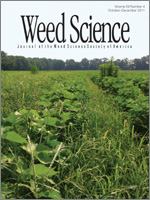Natural herbicides approved in organic agriculture are primarily nonselective burn-down essential oils applied POST. Multiple applications are often required due to their low efficacy. To address this problem, the in vivo herbicidal activity of manuka oil, the essential oil distilled from manuka tree (Leptospermum scoparium J.R. and G. Forst), was tested on selected broadleaf and grass weeds. While manuka oil exhibited good POST activity when applied in combination with a commercial lemongrass oil–based herbicide, it ultimately demonstrated interesting PRE activity, providing control of large crabgrass seedlings at a rate of 3 L ha−1. Manuka oil and its main active ingredient, leptospermone, were stable in soil for up to 7 d and had half-lives of 18 and 15 d, respectively. The systemic activity of manuka oil addresses many of the current limitations associated with natural herbicides. Additionally, its soil persistence opens up a multitude of new possibilities for the use of manuka oil as a tool for weed management and may be a potential bridge between traditional and organic agriculture.
Nomenclature: Leptospermone; 2,2,4,4-tetramethyl-6-(3-methyl-1-oxobutyl)-1,3,5-cyclohexanetrione, CAS 567-75-9; large crabgrass; Digitaria sanguinalis (L.) Scop. DIGSA.





